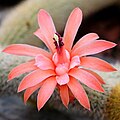Cleistocactus winteri
| Golden rat tail | |
|---|---|

| |
| Scientific classification | |
| Kingdom: | Plantae |
| Clade: | Tracheophytes |
| Clade: | Angiosperms |
| Clade: | Eudicots |
| Order: | Caryophyllales |
| Family: | Cactaceae |
| Subfamily: | Cactoideae |
| Genus: | Cleistocactus |
| Species: | C. winteri
|
| Binomial name | |
| Cleistocactus winteri D.Hunt
| |
| Synonyms | |
| |
Cleistocactus winteri is a
Description
This plant is a columnar cactus that forms huge tangled mounds of fairly rapid growth hanging or creeping, green shoots, up to 90 centimetres (35 in) high with stems 2 to 2.5 centimetres (3⁄4 to 1 in) in diameter and 16 to 17 ribs, with 50 spines 0.4 to 1 centimetre (1⁄8 to 3⁄8 in) long. The brown
It has salmon-pink flowers in spring and summer that are 4 to 6 centimetres (1+1⁄2 to 2+1⁄4 in) long and 5 centimetres (2 in) in diameter. Depending on the position of the shoots, the flowers are bent upwards to outwards to upright. The bracts are orange-red. The outer ones are radiating to slightly reflexed, the inner ones distinctly shorter and erect. Its flowers survive for a few days before transitioning to fruit for a short period of time which are 1 centimetre (3⁄8 in) long. The stamens and style protrude from the flower. The barrel-shaped, green to reddish-green fruits are 7 to 10 millimeters long and reach the same diameter.[5]
-
form
-
close-up
-
Flower
-
Flower buds of C. winteri subsp. colademonis
Subspecies
Recognized Subspecies:[6]
Distribution
Cleistocactus winteri is distributed in the Bolivian department of Santa Cruz in the province of Florida at altitudes of about 1400 to 1500 meters where it hangs on rocks.
Taxonomy
The first description as Winteria aureispina was in 1962 by
References
- ^ "The IUCN Red List of Threatened Species". IUCN Red List of Threatened Species. 2010-09-21. Retrieved 2023-09-01.
- ^ "Cleistocactus winteri".
- ^ "Cleistocactus colademononis". The Royal Horticultural Society. 2021. Retrieved 7 July 2021.
- ISBN 2-7328-1395-8.
- ISBN 3-8001-4573-1.
- ^ "Cleistocactus winteri D.R.Hunt". Plants of the World Online. 2015-09-06. Retrieved 2023-09-01.
- ^ "Au Cactus Francophone :". Au Cactus Francophone (in French). Retrieved 2023-09-01.
External links
 Media related to Cleistocactus winteri at Wikimedia Commons
Media related to Cleistocactus winteri at Wikimedia Commons Data related to Cleistocactus winteri at Wikispecies
Data related to Cleistocactus winteri at Wikispecies







